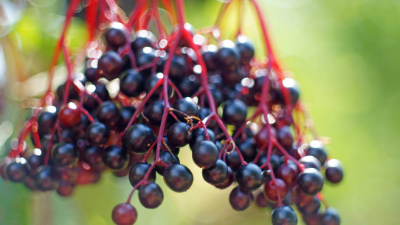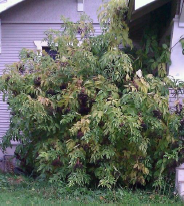How to Grow Elderberry in Your Garden

Summary
Elderberry (Sambucus spp) plants are native to North America with some species native to Utah. It is a very hardy plant that will grow to be a large shrub. The leaves are pinnately compound and serrated. Elderberry plants are fast growing and have large, cream colored flower clusters that are very showy. Light blue to black colored berries form in the late summer and are also ornamental. The fruit is bitter if eaten raw, but is excellent when processed, and the flowers can be dried and used to make tea. Elderberries can easily be incorporated into a landscape or garden for a unique and flavorful new fruit.Recommended Elderberry Cultivars
Until recently, the only cultivars available were older selections, mostly from New York and Eastern Canada. With renewed interest in growing elderberries, more breeding programs have begun working to develop new cultivars. ‘Wyldewood’ was selected in Missouri and has fairly good tolerance to alkaline soils. It produces large clusters with medium to large berries on first year shoots. ‘Adams 2’ is also tolerant to alkaline soils and yields medium sized berries in large clusters. ‘York’ is an older cultivar that produces the largest berries among current American cultivars and ripens early in the season. ‘Black Lace’ is a new purple-leafed cultivar that has beautiful ornamental characteristics, similar to a Japanese Maple, and also produces a good crop of fruit, but has not been widely tested in Utah’s alkaline soils. Some eastern cultivars have shown high levels of iron chlorosis on Utah soils. All of these cultivars will grow to be 6 to 8 feet tall and wide. Elderberries are pollinated by wind and insects. Although they are partially self-fruitful, having more than one cultivar will result in better pollination and higher yields.
How to Grow Elderberry
Site Selection
Although it can tolerate some shade, elderberry requires full sun for optimum production.
Soil
Elderberry grows in a wide range of soil types and conditions, but performs best in somewhat fertile, well-drained soil. Having your soil tested before planting will determine if any soil amendments need to be made. It is easier to amend and improve soils before planting than after, as elderberries have shallow roots that are easily damaged with cultivation. A soil high in organic matter that has a neutral pH and healthy nutrient levels will result in the best growth. Incorporating compost or other organic matter will improve soil nutrient levels and water holding capacity. In heavy clay soils, forming raised beds can help improve drainage.
Plant Material
Elderberries can be purchased commercially, either as bare-root starts or as potted plants. Purchasing from a reputable nursery will ensure healthy disease-free plants. The eastern varieties of Elderberry plants can also be propagated from either soft-wood or hard-wood cuttings. Hardwood cuttings should be taken in February or March, well before bud break, and soft wood cuttings root best when taken before July. Plants can also be successfully propagated from root cuttings, dug in late winter and covered in soilless media. The blue-fruited elderberry native to Utah is much more difficult to propagate, but softwood cuttings taken in late June are the most likely to root.
Establishment and Spacing
Dormant, bare root plants can be planted very early in the spring. Actively growing nursery container plants should not be planted until danger of hard frosts has past. It is best to establish plants before summer heat. Elderberry plants can be used as a landscape plant or planted in rows in a garden. Be sure to allow enough space around each plant; depending on the cultivar, approximately 4 feet in all directions is sufficient. If planting in rows, the plants can be set 2 to 4 feet apart, and the plants will fill in and create a solid row. If multiple rows are desired, leave 6 to 8 feet between rows.
Irrigation
Elderberries are quite drought tolerant. However, regular irrigation will maximize fruit production and quality. Plants can use 1 to 2 inches of water per week during the heat of summer. Mulching will help conserve soil moisture and reduce weed competition.
Fertilizer
Do not fertilize at planting, but a light application of nitrogen (1/4 cup ammonium sulfate per plant) about 2 months later can be beneficial. Mature plants that are actively producing should be fertilized with 1 cup ammonium sulfate per plant per year. Apply phosphorus and potassium based on soil test results.Pruning
To keep the plant vigorous and healthy, pruning should be done every year. Prune in February or March, while the plant is still dormant. Elderberry produces fruit on current year growth, 1-year-old and some 2-year-old canes. Start by removing all dead, damaged or diseased canes. Next, prune out all 3-year-old and older canes. Finish by tipping back weak canes and shaping the shrub.

Problems with Growing Elderberry
Weeds
Due to their shallow root systems, elderberry plants can be damaged if the soil is cultivated too deeply. Control perennial weeds before planting and maintain control by hand removing weeds before they seed. Annual weeds can be minimized by using mulch and hand weeding. There are several herbicides registered for use on elderberry, but caution should be taken when applying them. Always be sure to carefully follow the label. The pre-emergent dichlobenil can be used for elderberries and an early spring application will significantly reduce annual weeds in the coming months. Glyphosate and oryzalin are systemic herbicides registered for used on elderberries as a directed application. This means that the herbicide must not come in contact with the elderberry leaves or stems, and caution should be taken to avoid unintended drift that will damage the shrub. It is a good idea to use a shield, to keep herbicide spray off the plant.
Insects and Diseases
Elderberries are relatively pest resistant. However, some pests can cause a reduction in yield and plant health. Maintaining a healthy plant should be the primary pest control strategy. Remove and destroy all prunings, avoid irrigation practices that get water on the canopy, and closely monitor for pest occurrence. When pesticides are needed, consult and closely follow the label.| Pest/Disease | Identification | Control |
|---|---|---|
| Elder shoot borer (Achatodes zeae) | 1/2 inch long red-brown moths lay eggs in late summer. Eggs hatch following spring and black-spotted white larvae bore into new shoots, mining upwards. Watch for wilting shoots and piles of brown frass at the base of canes. | Prune out and destroy infested shoots. No chemical control available. |
| Verticillim wilt | Fungus that causes wilt or dieback in the tips of canes. These symptoms are often uniform across the plant. | Keep area weed-free as weeds can be alternate hosts. Avoid planting into a site that has recently had raspberries, strawberries, tomatoes or potatoes. Streptomyces lydicus WYEC can be effective if applied early. |
Harvesting, Productivity and Use of Elderberries
In Utah, elderberries can be harvested from early August to early October, depending on location and cultivar. Most individual plants will ripen over a 3 week period. Harvest the fruit by removing the entire berry cluster. Individual berries will need to be removed from the stems, which can be somewhat time-consuming. Freezing the entire cluster and then removing the berries while frozen will reduce skin tearing on the berry and can be faster than when the berries have not been frozen. Once removed from the stem, berries can be frozen for future use or processed. Elderberries are excellent for making juice, wine, extracts, syrup and jam. Mature elderberries produce approximately 2 to 3 pounds of fruit per plant.
Elderberry Nutrition Facts
Elderberries are rich in nutrients and are often sold as a health food. Many people use elderberry as a supplemental treatment for colds and flu. The fruit is high in flavonoids, vitamins A and C, iron, and vitamin B6.
References
- Byers, P.L., A.L. Thomas, M.M. Cernusca, L.D. Godsey, and M.A. Gold. 2012. Growing and Marketing Elderberries in Missouri. AF1017. Center for Agroforestry. University of Missouri. http://extension.missouri.edu/p/AF1017
- Cornell University Cooperative Extension. 2014. Cornell Pest Management Guidelines for Berry Crops. Eds. Marvin Pritts and Cathy Heidenreich. http://ipmguidelines.org/berrycrops/
- Stevens, M. 2001. Plant Guide for Common Elderberry (Sambucus nigra L. ssp. Canadensis) USDA-National Resources Conservation Service, National Plant Data Center, Baton Rouge, L.A. http://plants.usda.gov/plantguide/pdf/cs_sani c4.pdf
Published October 2014
Utah State University Extension
Peer-reviewed fact sheet
Download PDF
Authors
Tiffany Maughan and Brent Black
Related Research








